

*Personal Learning Network (PLN) Benefits, Tools, and Tactics. A personal learning network (PLN) is a group of colleagues, mentors, and professionals that you connect with to enhance your learning and take charge of your own professional development. It's a global, online community that allows you tap into a broad wealth of knowledge and focus on what you consider most important to your learning.
PLNs are especially valuable, as new information and ideas are changing the world at a much faster pace than ever before. The Difference Between PLNs and PLCs While often confused with PLNs, professional learning communities, or PLCs, are formal collaborations of educators working together to solve problems, build capacity, and ultimately help their students perform better. These groups are often formed under the auspices of a school or even mandated for educators to join, and the group process is highly structured.
*What Is A Personal Learning Network? What Is A Personal Learning Network?
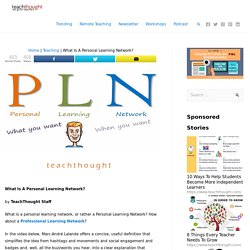
By TeachThought Staff What is a personal learning network, or rather a Personal Learning Network? How about a Professional Learning Network? In the video below, Marc-André Lalande offers a concise, useful definition that simplifies the idea from hashtags and movements and social engagement and badges and, well, all the buzzwords you hear, into a clear explanation that works not just within education, but any field. “A Personal Learning Network is a way of describing the group of people that you connect with to learn their ideas, their questions, their reflections, and their references. In that way, a Professional Learning Network, then, is a natural extension of the way people learn–by connecting with others who have shared interests, ideas, or resources. Interestingly, that view will continue to change as technology evolves.
*Professional Learning Networks (PLNs) for educators. *Dr. V's argument. *Connected Learning Principles. *Overview of connectivism - Dr George Siemens. *Will Richardson - Personal Learning Networks. *Jennifer's #20DayTwitterChallenge. *Technology Recommendations for Remote Environments. "Social Media: A Must Have for You & Your Library" - CSLA18 Conference Workshop by Jane Lofton.
Connected Learning: Everyone, Everywhere, Anytime. "Twitter 201: So, I Have a Twitter Account ... What Now?" CSLA18 Conference Session Recording. Professional Learning Networks (PLNS) The Networked Teacher. Networked Student. 15 librarians to follow on Instagram. It’s no secret that school librarians and libraries play a critical role in today’s schools and have a positive impact on student learning (don’t miss the School Libraries Work!
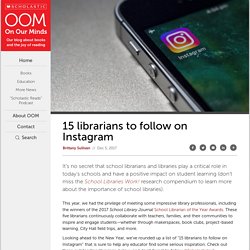
Research compendium to learn more about the importance of school libraries). This year, we had the privilege of meeting some impressive library professionals, including the winners of the 2017 School Library Journal School Librarian of the Year Awards. These five librarians continuously collaborate with teachers, families, and their communities to inspire and engage students—whether through makerspaces, book clubs, project-based learning, City Hall field trips, and more. Looking ahead to the New Year, we’ve rounded up a list of “15 librarians to follow on Instagram” that is sure to help any educator find some serious inspiration. Elearnspace. Connectivism: A Learning Theory for the Digital Age. Connectivism: A Learning Theory for the Digital Age December 12, 2004 George Siemens Update (April 5, 2005): I've added a website to explore this concept at www.connectivism.ca Introduction Behaviorism, cognitivism, and constructivism are the three broad learning theories most often utilized in the creation of instructional environments.

Learners as little as forty years ago would complete the required schooling and enter a career that would often last a lifetime. “One of the most persuasive factors is the shrinking half-life of knowledge. Michelle Cordy Connect with your PLN to empower & engage students: ISTE 2016. Why Every Leader Needs a PLN. The concept of a Personal Learning Network (PLN) has been around for a couple of years now.
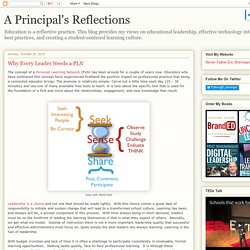
Educators who have embraced this concept have experienced firsthand the positive impact on professional practice that being a connected educator brings. The premise is relatively simple. Carve out a little time each day (15 – 30 minutes) and use one of many available free tools to learn. TEDxNYED - Henry Jenkins - 03/06/10. Social Capital and New Communication and Information Technologies. Rheingold: Network Literacy Part Two. 23 Things for Digital Knowledge. Thirty years ago, networks developed for communication between people were adapted to communication between machines.

Since then we’ve gone from transmitting data over a voice network to transmitting voice over a data network. Digital forms of information and communication are transforming what it means to work, study, research, and express oneself. Shannon McClintock Miller at BLC14 - Being a Connected Educator. Why Connected Learning? - Connected Learning Alliance. Connected learning is when someone is pursuing a personal interest with the support of peers, mentors and caring adults, and in ways that open up opportunities for them.
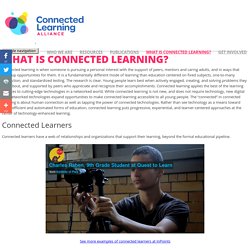
It is a fundamentally different mode of learning than education centered on fixed subjects, one-to-many instruction, and standardized testing. The research is clear. Flipgrid on Social Capital. Designing the Library of the Future for and with Teens: Librarians as the “Connector” in Connected Learning (Subramaniam) Hanging Out. George Siemens - Connectivism: Socializing Open Learning. Online Communities of Practice Design Guidelines. Educational Hash Tags. Learning in the Modern Workplace is much MORE than courses and resources – Learning in the Modern Workplace. Jane Lofton's Blog: How to participate in a live chat. I'm delighted to report that we (Katie McNamara and I) moderated our first #calibchat Twitter live chat on April 27, and a good - and productive - time was had by all!
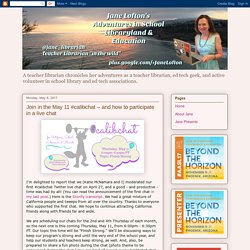
(You can read the announcement of the first chat in my last post.) Here is the Storify transcript. We had a great mixture of California people and tweeps from all over the country. Thanks to everyone who supported the first chat. We hope to continue attracting California friends along with friends far and wide. I promised last time to give some tips for those new or newish to live chats on how to participate.
How to Get Started with Twitter Chats - Simplek12. 5 Minute Librarian: Social Media. This week, we invite all library Instagram accounts to participate in our October Challenge: 31 Days of Instagram!
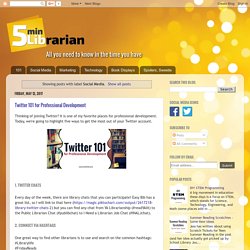
I have a confession: I have a very sad library Instagram account. I know I should be posting daily (some stats say twice a day), but making the time to take photos, find relevant/popular hashtags, and posting them when teens get out of school -- it was overwhelming. So, this challenge is for those who are in the same boat and those who want to learn how to use Instagram in the most painless way possible. I researched what worked for other libraries, shared additional programs that'll make your life easier, and provide popular hashtags that you can easily use over and over again. Sound good? NOTE: Any hashtag in red needs to be specific. 1. First, find your city's/town's most popular hashtag. Now, take a photo of your library (any part of it or room, or the whole building) and post it.
Hashtags to use: #citystate #libraryname #librariesofinstagram #5minlibchallenge 2. What Does Connectivism Mean for Education? The theory of Connectivism provides new insight into what it means to facilitate learning in the 21st Century.

Those responsible for teaching and training need to incorporate instructional strategies that match learner expectations and the physical changes that technology has wrought on the human brain. This is an ongoing challenge and one that does not have a single right answer or pre-packaged solution. Tips from the ISTE Young Educator Network. Elearnspace. Connectivism: A Learning Theory for the Digital Age. Build Your Own and Your Students' Global Personal Learning Networks with Twitter. Expect the Miraculous. Brad Spirrison Talks about Participate.com.